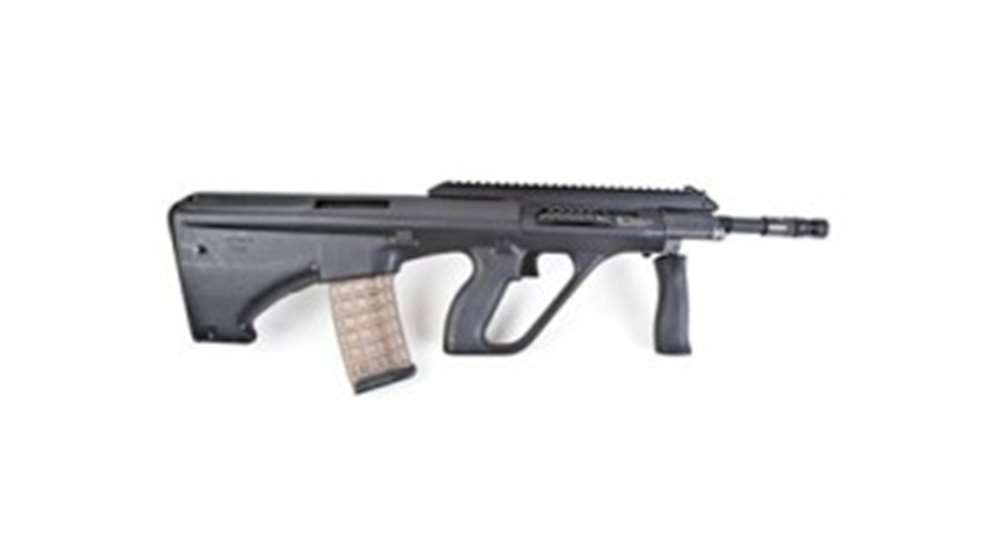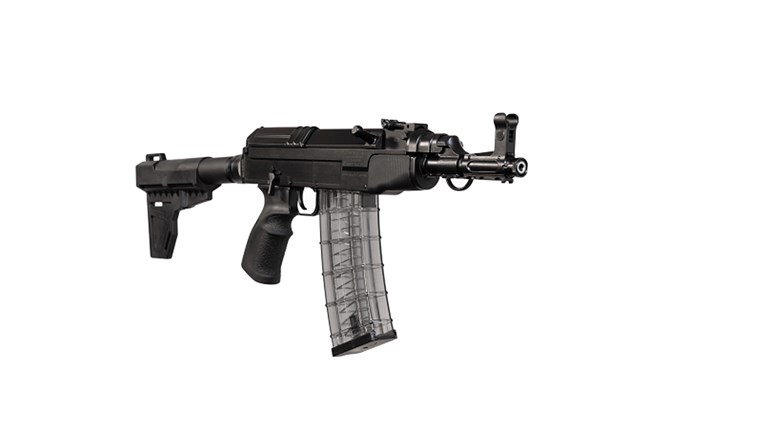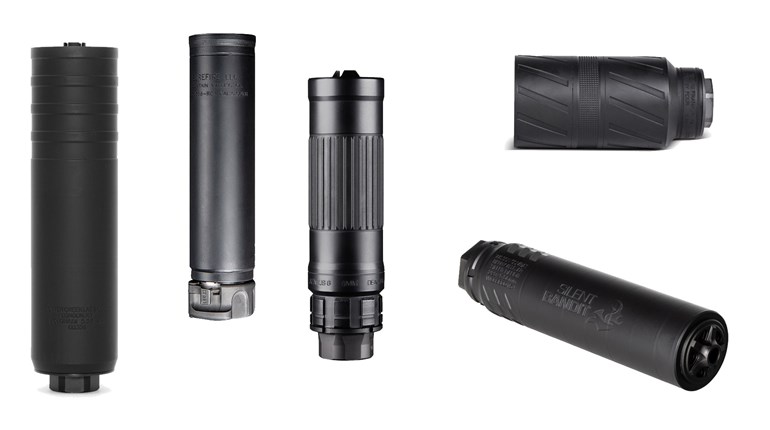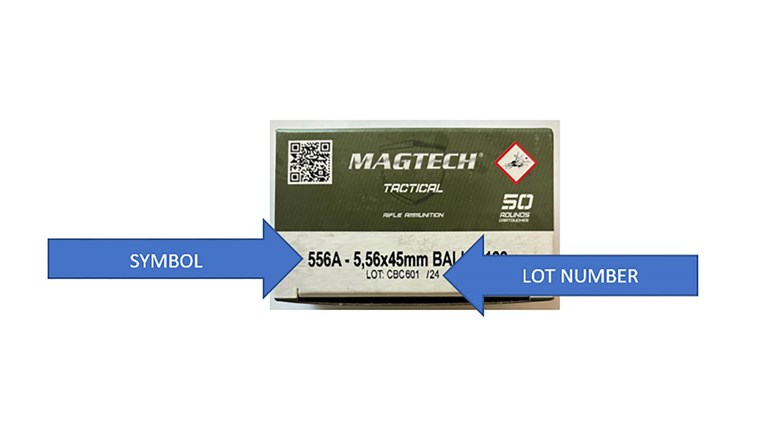
Friedman: Britain, France, Israel, Austria, Singapore, Australia, China and others have either adopted a bullpup service rifle or are experimenting with a bullpup to replace their current model. If they are so awful, why are so many fully competent militaries adopting them? Aren't we just being arrogant Americans?
Adelmann: If by "competent" you mean capable of marching polished troops down the Capitol City main drag, you have me there. But if you mean countries with troops that have a consistent record of distinguishing themselves on battlefields, you need to trim that list by more than half. Most of those you listed have either been invaded and occupied or would have been were it not for the aid of a bunch of American GIs shooting conventionally stocked rifles, repeatedly.
The SA80 is so awesome that when it first hit UK troops' hands that it had to be sent to another (competing) manufacturer to be reengineered so it would function. The current, functional version is so much better that the only troops carrying it are the ones who have no choice (conventional forces). Look closely at what their Spec Ops troops carry and you'll see another tale. As for the FAMAS, well, the fact that France carries it makes my point. You're making this too easy.
Friedman: Ah, the "Bash the French" line. French surrenderism, for all its flaws, has no impact on the quality of their weapons. The FAMAS may never be fired and dropped only once, but if used by a military that chooses to fight, it is a capable little rifle. While Britain did have problems with the SA80, it and all bullpups offer a distinct advantage in urban/suburban combat. The ability to include a full-length barrel while shortening overall length should not be discounted simply because some warm-beer-drinking Scousers made a mediocre gun.
As to your initial argument, that competent militaries do not carry bullpups, I give three examples. First, Israel is changing over to the Tavor, and it has a pretty darn good military (one that wouldn't parade down a street if forced at the point of a bayonet). Second, China is slowly fielding the QBZ-95, and from what I've read, it is the primary weapon of the People's Liberation Army's elite forces. Now China may rely more on manpower than marksmanship, but the decision of a 3 to 5 million-man army shouldn't be discarded simply because most of them are cannon fodder. China did whup the Red Army in their border conflicts, as I recall. Lastly, I present Georgia (the country, not the birthplace of Jimmy Carter). Now, here's an odd choice, right? I mean, the Georgian military has only about 23,000 active-duty troops, so why include them? Well, about 1,000 of their special forces are about to deploy alongside our men and women in Afghanistan. According to what I've seen, they fight hard, fight well and hold their own, even when facing long odds. They also happen to carry Tavors. If we trust them to fight alongside our troops in combat (one of my good friends will be a liaison officer with the Georgians when they deploy), it stands to reason we don't think their guns will regularly cease functioning or miss targets.
So basically, the bullpup, like all weapons, is a series of compromises. For the modern battlefield, however, it is an ideal compromise that allows the chambering of rifle-caliber rounds in a compact package for both urban and conventional combat. Given our military's struggles with the M16/M4 in Iraq and Afghanistan (leading to the fielding of the SCAR and the Marine Corps IAR program) the question must be asked, why have we seemed to ignore the bullpup?
Adelmann: If we use the foreign influence logic for how Americans should live we'd all be chain-smoking, sardine-can driving, cheap-cologne "showering," espresso-drinking pretenders that our way of life is far better than those we secretly emulate. In other words, to do what works best for us is to be American. After 21 very active years as an Army grunt it's not hard to look back and thank God that I wore an American flag on my uniform. Remember that while we entered World War II wholly unprepared, it was American ingenuity and tenacity that armed most of our GIs with M1 Garands. This was at a time when the bulk of allied and axis troops still carried bolt-action rifles because they were stronger, more reliable and more accurate. They were technically correct, yet we still kicked the crap out of the bad guys in the end. I'm pretty sure all those other countries went into semi-auto hyper-drive once they saw the effect of well-aimed, voluminous GI .30-06 headed downrange.
Now let's apply that metric to the bullpup pros and cons argument. You mentioned "a distinct advantage in urban/suburban combat." No doubt you're referring to the ability to configure a bullpup with a shorter OAL for the same barrel length and the potentially reduced signature. With respect to telegraphing one's movements around corners or over obstacles, the only troops who ease their barrels—of any length—around corners before their bodies and survive a gunfight are in the movies. There are right and wrong ways to deal with corners and other obstacles, dictated by enemy fire, other danger areas (an intersection) and whether you've got team members with you. Clear a corner or obstacle the wrong way with a 3-inch barreled .357 Mag. and you'll be just as dead as with an FAL. Clear it the right way—by "pie-ing" it off or with fellow team members using combat-proven tactics, techniques and procedures—and you can do it with anything in hand. As a guy who made a habit of carrying various 14.5- 16- and 20-inch semi-auto .308s through several busy combat tours, I'm living proof.
It's easier to manage your profile's projected length in the urban environment than it is to reduce your signature's width when engaging around cover. The most effective way to do this is to shoot both weak and strong hand, determined by the side of cover being used. This isn't something all troops train to do but its gaining momentum in our military, thanks to the Special Operations community and some very good civilian trainers. With the right type of sling (V-Tac's are the best example) a trained shooter can easily switch from right- to left-handed firing faster than you can say "the Tavor rocks," and quickly reduce the amount of body that's inevitably available as a target. The majority of bullpup designs out there advertised as being ambidextrous actually require some manner of reconfiguration for opposite-side ejection. In some cases they must be fired right-hand only. Neither option will work in a dynamic urban gunfight. While the Kel-Tec RFB uses forward ejection, another avenue for functional problems in real combat environments is opened up by virtue of the RFB's need to feed two items (cartridge and spent case) instead of the normal one. For the forward-eject concept to pass muster, it has to work in the same demanding environments conventional rifles and carbines function in with the same levels of maintenance. Further, there should be a mechanism for clearing stoppages through immediate action in a design that doubles the potential for feeding problems. I'm not saying a good forward- or bottom-ejection design can't be made reliable in all environments—talc sand, mud, extreme cold weather, jungle—I just don't think any current designs have been tested that way.
You asked why we've seemed to ignore the bullpup. I submit that our military hasn't ignored them at all. In fact I can say several have been tested over the years and the results are always the same. As you've pointed out, the SCAR and other new weapon systems have been adopted in recent years so no argument can be made that we're stuck in a rut with what's mentally comfortable. Physical comfort is another story altogether, and I'll take what feels good in hand over what looks good slung like a commando purse any day of the week.
Friedman: A little foreign influence would have saved a bunch of lives in World War I, had we listened to the *gasp* French, or even in the early days of World War II in North Africa. We might also have avoided 2004 to 2006 in Iraq had we listened to some of the Aussie or British folks with counterinsurgency expertise. But, enough about foreign influence. I have zero combat experience and far less expertise with proper movement than you, but I think that is largely the point. Elite units have always required different weapons than regular infantry. What works best for the SAS might be useless in the hands of a raw recruit. While SOF units train constantly on the techniques needed for direct contact, most line-infantry units don't. This is especially true for conscript armies. While the U.S. has an all-volunteer force that is highly trained and far more capable than the majority, if not all, of the world's armies, our regular units simply do not train the way our elite units train. Therefore, what works best for, say, DEVGRU is unlikely to become SOP for the rest of the Navy or an Army Field Artillery (FA) unit. Yet many regular units are engaging in tasks once left for SOF (or for strategic bombing, but that's not very PC these days), like clearing urban environments of insurgents and terrorists. These units might, I would argue likely, benefit from the shorter OAL of a bullpup rifle. Of course they would benefit more from better training, but that would lead to problems like that which we currently have, where an FA unit must train to clear a village rather than deliver a time-on-target (TOT) barrage. If the Norks get uppity, we're more likely to need the TOT than the village-clearing (and the TOT can be used for such village clearing anyway :), but our FA units will be less proficient in their primary function because they've spent more time training as urban light infantry than as artillerymen. To raise a regular soldier to the elite level, where a bullpup may be a disadvantage, would only deepen this problem. For an average soldier, the bullpup may offer a fine compromise that makes him or her a better asset in urban and suburban combat. You snake eaters can get all the cool gadgets anyway, so adapting a bullpup would not change the way SOF folks operate.
Adelmann: Let's get something straight: snake really isn't that good and anyone that tells you it tastes like chicken probably never ate at KFC. OK, now let me point out your flawed logic. First, I'm speaking as both a former conventional Soldier as well as a SOF veteran. While I spent 3/4 of my Army career doing sneaky things, I spent my formative years (including early combat tours) as an airborne infantryman. My first exposure to bullpups transpired on the rifle range, alongside British exchange troops from 1 Para. We all traded rifles for familiarization but it didn't go well…for the Brits. Our M16A2s never missed a beat and their SA80s seldom got through 5 rounds without a hard-to-clear malfunction. Our guests blamed it on our M855 ammunition, claiming it wasn't running at the same pressures as their usual Radway Green stuff. I remember thinking at the time how that negated the common NATO cartridge theory. I push all manner of 5.56 ammo through the ARs I build—heavy doses of surplus SS109 included—and they digest it all without a hiccup. My fellow Scouts and I left the range that day very unimpressed and the Brits left very embarrassed, audibly pining for their old L1A1s.
Modern combat encumbers our troops with more individually worn equipment than ever before. Most of that gear is mounted on the front of the torso—usually projecting several inches. Because 95 percent of the bullpup's mass is concentrated directly in front of the body, every edge, corner, lever and control is perfectly positioned to catch on individual gear. The days of only SOF troops wearing assault vests are long over. Whether you escort supply convoys or place precision breaching charges on doors and clear rooms, all that chest-mounted kit acts like tiny grappling hooks on your primary long-arm. Increasing the amount of gun against the body only exacerbates the problem.
People who shoot and move—competitors and troops alike—need to traverse and elevate their rifles and carbines smoothly and efficiently. Placing the support hand as far out as possible is a great way to do that. When shooting a bullpup, the shorter OAL means the support hand will be positioned much closer to the body. The result is a slower, sloppier transition from target to target due to less leverage and natural balance. It's the same physics that ensure no clay target championships are won due to the portability of 18-inch-barreled shotguns.
The short OAL and weight re-distribution are often cited as the bullpup's key advantages. If that were all that mattered we'd all be carrying 5.56 NATO "pistols," but we don't so there must be more to the story. The follow up point normally goes something like "Yeah, but you have to sacrifice barrel length to get a regular carbine down to the size of a bullpup." That's true but then the first bullpups—the British EM1 and EM2 I believe—came about long before modern technology delivered premium powders and projectiles along with the concept of one rifle with multiple uppers or barrels. Why in this day and age would you choose a bullpup for the sole benefit of a shorter OAL/longer barrel when you can change barrels or uppers on modern combat rifles in less than a minute? Even without the benefit of multiple barrels or uppers our modern cartridges turn in mid- and long-barrel performance in shorter barrels.
I'll close with an observation about our military men and women. While it was true that for many years only SOF elements trained regularly for dynamic combat operations in urban environments, that's no longer the case. Not only do we have the most experienced combat force in 65 years, our conventional troops have been aggressively learning new tactics, techniques and procedures and upgrading their equipment at every turn. Even support troops regularly "go to school" on lessons learned by SOF and the refresh rate for info sharing happens very quickly these days. I can name hundreds of specific items that have transitioned from SOF to conventional troops in all branches, but I'll highlight just one example. Gun lights are a common sight today, but this wasn't always so in the US military. In 2003 I was in the middle of my first Operation Iraqi Freedom tour when I saw a group of 4th Infantry Division Soldiers with SureFire 6P lights on their rifles. I smiled inwardly upon seeing that this critical and simple tool had finally trickled down to regular troops. In March, 2010, I saw TV footage of Iraqi soldiers guarding the polls with lights on their guns and realized we've come a very long way in a short time. As recently as the late '90s, I could count on one hand—with fingers left over—the number of military units that issued weaponlights to their troops. Now everyone has them. Never assume that just because SOF has the ability to pick the best equipment that no one else will benefit from the downward trickle of progress. It took years to push those SureFire lights to the "regular" military but that isn't the case today. From high-performance rifle ammunition and reflex sights to effective body armor there's ample evidence that "cool gadgets" aren't just a perk for SOF units anymore. In the end, it seems to me the bullpup's key advantages have been outpaced by the natural flow of combat evolution and firearms industry developments. In my opinion this unique design's disadvantages will be felt by anyone who trades a solidly ergonomic battle rifle for something that carries slightly more comfortably than a cinderblock with a handle.





































